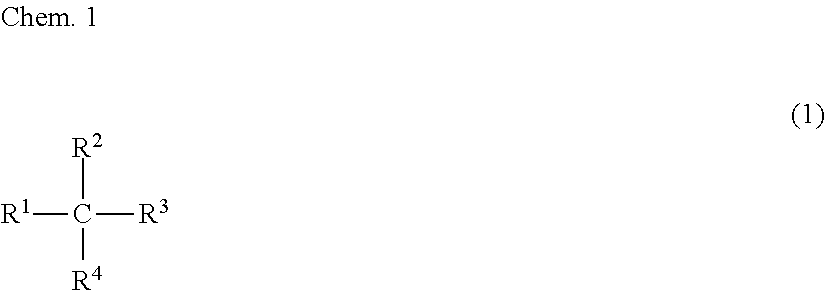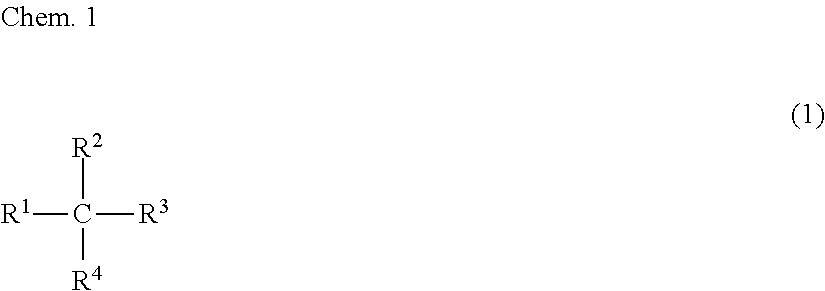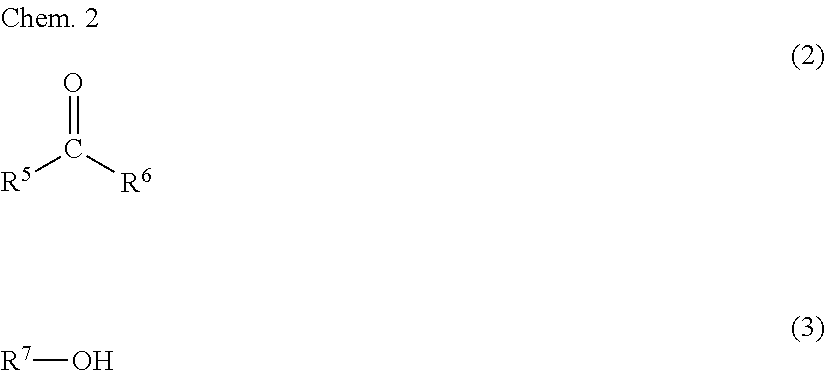Ionic liquid and method for producing the same
a technology of ionic liquid and production method, which is applied in the direction of non-aqueous electrolyte cells, fused electrolyte fuel cells, dissolving, etc., can solve the problems of long time-consuming and laborious water removal, insufficient moisture removal by vacuum drying, and inability to remove water by vacuum drying, etc., to reduce the cost of production of ionic liquid and shorten the time required to remove water
- Summary
- Abstract
- Description
- Claims
- Application Information
AI Technical Summary
Benefits of technology
Problems solved by technology
Method used
Image
Examples
embodiment 1
[0044]One embodiment of a method for producing an ionic liquid according to the present invention is described below.
[0045]Here, details of the method for producing the ionic liquid are described first. Then, materials suitable for the method according to the present invention for producing the ionic liquid are described.
[0046](Properties of Ionic Liquid)
[0047]The ionic liquid is a composition, which is also referred to as ion liquid, ionic fluid, or ambient temperature molten salt. More specifically, the ionic liquid is a composition whose main component is a molten salt constituted by bonding a cation portion and an anion portion. In this Description etc., the term “main component” is a component that takes 50% by mass or more of the whole composition. It is preferable that the main component takes 90% by mass or more of the composition, and it is more preferable that the main component takes 100% by mass or more of the composition.
[0048]In the present Description etc., what is me...
example 1
Synthesis of Salt Containing Cation Portion
[0110]In 4-necked flask of 200 ml, 16.42 g (0.200 mol) of 1-methylimidazole, 20.37 g (0.220 mol) of 1-chlorobutane, and 10.00 g of toluene were added and stirred for 17 hours under reflux (approximately 106° C.). After they were reacted in this way, a reaction solution was cooled (air-cooled) to 70° C. or below. Then, 30.00 g of ultra pure water was added therein, the resultant solution was water-cooled to room temperature.
[0111]After the cooling, an upper layer (toluene layer) of the solution was separated off from the solution by using a separating funnel. To a lower layer (water layer), 20.00 g of toluene was further added. After the resultant solution was stirred for 30 min, an upper layer (toluene layer) was separated off from the solution by using a separating funnel, thereby remaining a water layer in which N-methyl-N′-butyl imidazolium chloride (hereinafter, referred to as [BMIm]Cl) being a cation portion of an ionic liquid was cont...
example 2
Synthesis of Salt Containing Cation Portion
[0121][BMIm]Cl was synthesized in the same manner as in Example 1.
[0122](Anion-Exchange Reaction)
[0123]A white slurry in which [BMIm]DCA served as a solvent was prepared in the same manner as in Example 1, except that evaporation under reduced pressure was carried out at 60° C. under 20 mmHg for 2 hours.
[0124](Salt Removing Step)
[0125]After 60.00 g of acetone was added thereto, the white slurry was cooled to approximately 0° C. to 5° C. and stirred for 30 min, thereby crystallizing out sodium chloride and unreacted sodium dicyanamide. The sodium chloride and unreacted sodium dicyanamide thus crystallized out was filtered out with a Buchner funnel having an internal diameter of 55 mm. Crystals thus obtained were washed with acetone (30.00 g). A solution thus obtained was filtered to get a filtrate. The filtrate was then transferred to an egg-plant-shaped flask of 200 ml and evaporated under reduced pressure at 50° C. under 20 mmHg for 1 hour...
PUM
| Property | Measurement | Unit |
|---|---|---|
| boiling points | aaaaa | aaaaa |
| temperatures | aaaaa | aaaaa |
| temperatures | aaaaa | aaaaa |
Abstract
Description
Claims
Application Information
 Login to View More
Login to View More - R&D
- Intellectual Property
- Life Sciences
- Materials
- Tech Scout
- Unparalleled Data Quality
- Higher Quality Content
- 60% Fewer Hallucinations
Browse by: Latest US Patents, China's latest patents, Technical Efficacy Thesaurus, Application Domain, Technology Topic, Popular Technical Reports.
© 2025 PatSnap. All rights reserved.Legal|Privacy policy|Modern Slavery Act Transparency Statement|Sitemap|About US| Contact US: help@patsnap.com



